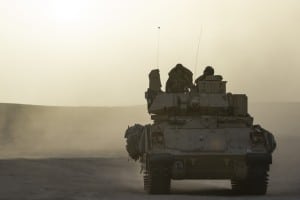The Army on Friday released a draft request for proposals for the preliminary design phase of its restarted Optionally Manned Fighting Vehicle (OMFV) competition, with plans to award up to five contracts next June for digital design prototypes.
Army officials will gather industry’s feedback on the draft notice
in the latest step in its Bradley replacement program, before issuing a final RFP later this year.

“As we continue to progress through the first phase of our five-phased approach for the OMFV program, communication, inclusive feedback and innovative thinking from industry remains key,” Maj. Gen. Brian Cummings, program executive officer for Ground Combat Systems, said in a statement. “We are looking forward to receiving feedback and learning from industry what’s in the realm of the possible as we continue to develop this truly transformational vehicle for our soldiers.”
The Army said earlier this year it would cancel its original acquisition effort for OMFV, which faced scrutiny after a single bid sample from General Dynamics [GD] was accepted for the program’s prototype phase.
The rebooted competition’s initial phase focuses on digital designs rather than physical prototypes, with the draft RFP reinforcing the Army’s move away from prescriptive requirements and toward having industry inform vehicle characteristics through a bolstered feedback process.
“Accurately defining the desired set of capabilities without over-constraining the design is critically important,” Brig. Gen. Ross Coffman, director of the Army’s Next-Generation Combat Vehicles Cross Functional Team, said in a statement. “The Army is committed to open communication with industry to ensure the characteristics and eventual requirements of the OMFV are informed by technological advances.”
The draft RFP does note that the Army may consider submitting its own design for OMFV phase one that could compete against industry’s proposals.
The Army has previously detailed its five-phased approach for OMFV, which include downselecting from five to three vendors in FY ‘23 to continue working on digital prototype designs and eventually culminating in critical design reviews (Defense Daily, April 10).
Phase 4 will include building physical prototypes before conducting a series of vehicle tests between FY ‘25 and early FY ‘27.
A production contract to one vendor is ultimately slated for the second quarter of FY ‘27